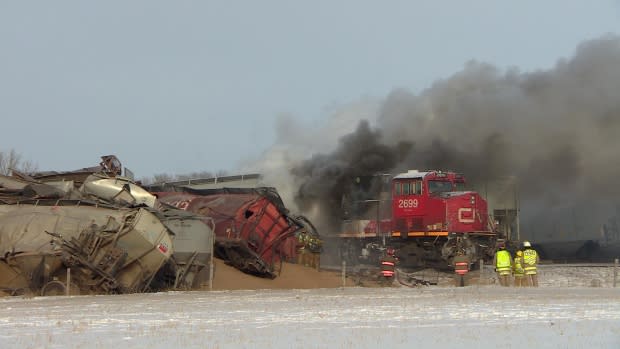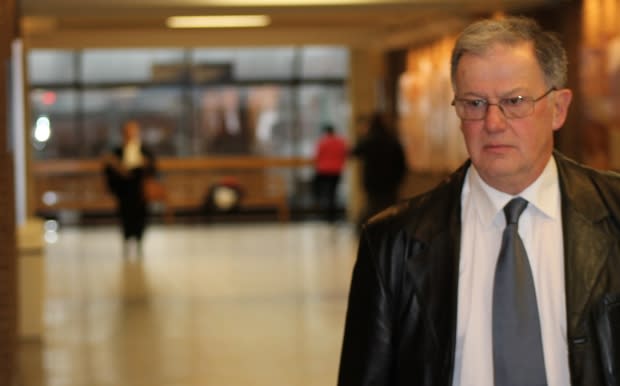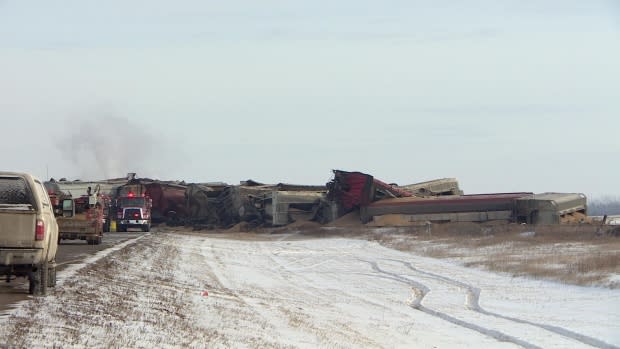Expert who investigated Lac-Mégantic disaster calls for action from CN, province after Saskatoon derailment
The rail safety expert who helped police investigate the Lac-Mégantic train disaster wants the province of Saskatchewan and CN Rail to reassess the safety of a crossing where a train jumped the tracks and caught on fire just north of Saskatoon earlier this week.
Retired Transportation Safety Board senior investigator Stephen Callaghan — who was an expert Crown witness at the 2017 trial of the men accused in the Lac-Mégantic crash — says when he first saw footage of the Tuesday derailment, where 30 cars on a train hauling grain derailed in the middle of the Highway 11 crossing, he was struck by how the Canadian National Railway line crossing was set up.
The crossing has prominent flashing lights to signal oncoming trains, a stop line and advanced warning signs. And while it follows federal regulations, Callaghan says the trains got too close for comfort to a truck at the front of the crossing.

In his view, if the driver right at the front hadn't had the quick reflexes to back up and get out of the way as the grain cars smashed into each other right in front of the truck, that vehicle would have been hit.
"It's not that the vehicle drivers were not respecting the signage or the stop line. They fully respected that," says Callaghan.
"Maybe if the stop lines were a little further back in that case, the risk would be minimized."
The Transportation Safety Board is investigating the cause of the derailment, and has not yet released any details on what happened.
While that investigation is underway, Callaghan says more can be done by Saskatchewan's Ministry of Highways and CN Rail, particularly because of what he calls "substantial" railway traffic that carries heavy materials like grain, potash and other potentially dangerous goods.
"I think that they should reassess the actual criteria of crossing safety for this particular crossing. They should do a complete risk assessment for the crossing," he says.
Some of the considerations include moving stop lines further back, fully gating the crossing, and building an overpass — which Callaghan acknowledges may be too pricey, or not environmentally possible, at that spot.
While the footage of the derailment brought the crossing's risks — including poor sightlines for traffic — to Callaghan's attention, he says it would concern him even if the fiery crash hadn't happened.

With the speed trains go through, if one of the many 18-wheel semis that also go through that crossing was to ever blow past the lights and get hit, it would almost certainly cause a derailment, Callaghan says. Almost all crossing accidents are fatal, he said.
He personally knows train operators who have faced the trauma of a fatal collision, and has investigated some of the worst train crashes to happen in Canada — including the crash in Lac-Mégantic, where a runaway train derailed and exploded, killing 47 people in the early hours of July 6, 2013.
"When you're faced with that situation as a human being, you take a look at that and say, 'Does this have to happen?'" Callaghan said.
Installing crossing arms at the Saskatoon crossing is not a big ask, he says. He mentioned a less-trafficked area in Quebec that has crossing arms, and it runs far fewer trains than the Saskatoon crossing.
Transport Canada's May 2018 Railway Safety Act review recommended more money for railway crossing safety. It also asks Transport Canada to prioritize projects that close railway crossings or separate trains from traffic.
Possible causes
As for what may have caused the derailment, it could have been a defective train car wheel, or maybe a broken axle, says Gordon Lovegrove, an engineering professor at the University of British Columbia with experience in transportation safety.
"If one of those wheels has problems, it affects the entire truck. Once a truck is off, the car is off and the whole train, because it's all … coupled together."
Rail equipment is carefully manufactured and tested, Lovegrove says.

"To me it's a freak accident. This is something that doesn't happen often but where you have wear and tear, cold climate and steel is mixed — so many variables," he says.
Based on footage he's seen of the crash, Lovegrove says it's unlikely the rail tracks were the cause, since the "biggest enemy to a railbed is water." That's minimized here, since it's winter and there's no flowing water, and the crossing is in what appears to be a flat, well-drained location.
The main cause of derailments between 2007 and 2016 was equipment and track failures, according to the 2018 Railway Safety Act review.
